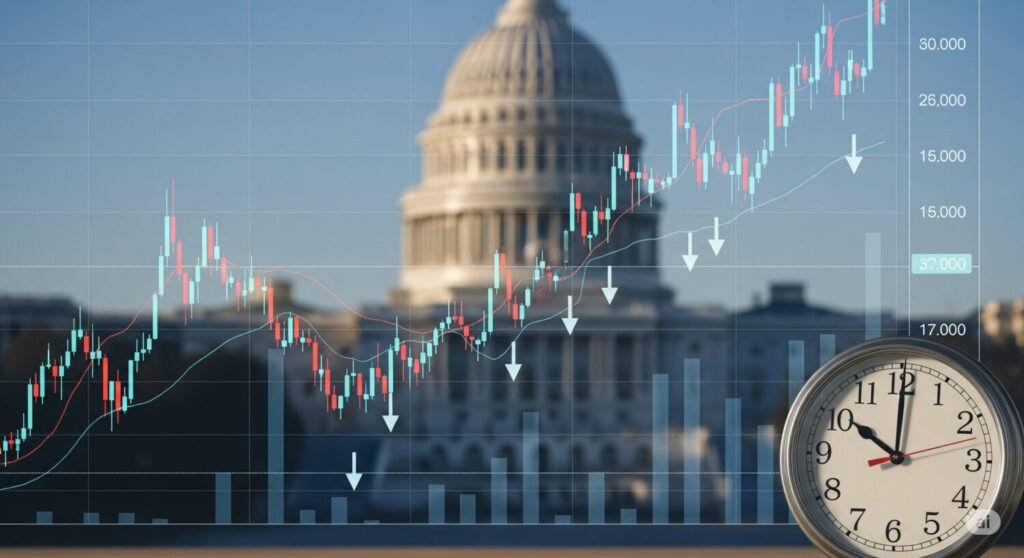US stock futures dip after record highs. Explore what’s driving this pullback, from federal policy to Fed rate signals, and what it means for your portfolio.
The U.S. stock market has been on a wild ride recently, hitting record highs, but a noticeable shift occurred as futures for the Dow, S&P 500, and Nasdaq experienced a slight dip. After celebrating Monday’s record-breaking closes, investors are now keenly observing a mix of political maneuvers and economic indicators that could shape the market’s trajectory in the coming days.
Why the Recent Market Pullback?
Following an impressive rally, it’s natural for markets to take a breather. The slight downturn in futures comes as investors digest recent gains and anticipate new information. Several key factors are contributing to this cautious mood:
- Dow futures saw a modest dip.
- S&P 500 futures also slipped.
- Nasdaq futures experienced a similar decline.
This cautious sentiment is also influenced by specific company news, such as Tesla’s stock declining amid renewed tensions between Elon Musk and President Donald Trump. Traders are reacting swiftly to every headline, especially in a shortened trading week leading up to the Fourth of July holiday.
The Market’s Recent Performance
Before this slight dip, the stock market had a strong run. Monday saw both the S&P 500 and Nasdaq reach new record highs, propelled by robust performance in the technology and AI sectors. The Dow Jones Industrial Average also gained significant ground, nearing its all-time peak.
The second quarter of the year wrapped up on a high note, showing impressive year-to-date gains:
- S&P 500: Up 5.5%
- Nasdaq: Also up 5.5%
- Dow Jones: Gained 3.6%
These figures highlight the strong momentum that has characterized the market in recent months, making the current slight pullback a point of interest for many.
Trump’s Tax and Spending Bill: A Senate Showdown
A significant factor on investors’ minds is President Trump’s large-scale tax and spending package. Senators have been working tirelessly to finalize this bill, which is a cornerstone of the President’s domestic agenda. The goal is to have it signed into law before July 4th.
While the bill has faced internal debates within the Republican party, one crucial amendment garnered strong bipartisan support: the removal of the federal ban on state-level AI regulation. This could be a game-changer for major tech firms that have generally opposed increased AI oversight. The progress of this bill will undoubtedly continue to influence market sentiment.
Trade Talks and Tariffs: A Shifting Landscape
The July 9th deadline for the return of Trump’s reciprocal tariffs is looming, adding another layer of uncertainty. Reports suggest the U.S. is quietly recalibrating its aggressive stance on “reciprocal” trade deals. Instead of sweeping agreements, officials are now reportedly seeking more limited arrangements.
This shift indicates a more flexible approach, potentially aimed at alleviating market concerns about a new round of global trade disruptions. Renewed trade talks between the U.S. and Canada, particularly Canada’s decision to drop its proposed digital tax, have already eased some tensions, especially for major tech companies. However, the extension of key tariffs beyond the upcoming deadline remains a significant question mark.
Federal Reserve and Interest Rate Hopes
Another critical event for the markets this week is Thursday’s job report. Investors are closely scrutinizing this data for any signs of a cooling labor market, which could increase the likelihood of a Federal Reserve interest rate cut.
Optimism is building that the Fed might act sooner to support the economy if job growth shows signs of slowing. A weaker-than-expected report could provide a stronger argument for cutting interest rates, aiming to stimulate consumer and business spending in the latter half of 2025. This anticipation is a major driver of market activity right now, alongside the ongoing trade discussions.
The current market environment is a blend of cautious optimism and anticipation. As Washington navigates its legislative agenda and economic data rolls in, investors will remain vigilant, ready to adjust their strategies to the evolving landscape. Navigating the Current Market: What’s Driving the Recent Dip?
The U.S. stock market has been a rollercoaster lately, with major indices like the Dow, S&P 500, and Nasdaq hitting impressive record highs. However, we’ve recently seen a slight pullback in futures, leaving many investors wondering what’s next. Let’s dive into the key factors influencing this shift and what it means for your portfolio.
A Brief Pause After Record-Breaking Gains
After a strong run that saw the S&P 500 close above 6,200 for the first time, futures for all major indices have edged down. This isn’t necessarily a cause for alarm but rather a moment for investors to digest recent gains and look for fresh guidance.
- Dow futures are down slightly, around 0.13%.
- S&P 500 futures have slipped about 0.22%.
- Nasdaq futures saw a drop of roughly 0.27%.
This minor dip suggests that traders are taking a breather, waiting for more clarity on political and economic developments before making their next big moves.
Trump’s Budget Bill and Its Market Impact
A significant focus for Wall Street is President Trump’s large-scale tax and spending package. Senators have been working tirelessly to finalize this bill, with the President aiming for it to be signed into law by July 4. This legislative push is critical for his domestic agenda and could have broad implications for various sectors.
One notable development within the bill is an amendment that removes the federal ban on state-level AI regulation. This could be a game-changer for major tech firms, many of whom have previously aligned with Trump’s stance against extensive AI oversight. The passage of this amendment could reshape the regulatory landscape for artificial intelligence, impacting how tech giants operate and innovate.
Trade Tensions and a Shifting Strategy
Another element influencing market sentiment is the evolving landscape of U.S. trade policy. With a July 9 deadline looming for the return of Trump’s reciprocal tariffs, there’s been a noticeable shift in strategy. Reports indicate that the U.S. is scaling back its aggressive push for sweeping trade deals, instead opting for more limited arrangements.
This more flexible approach is likely an effort to calm markets, which are often sensitive to the prospect of renewed global trade disruptions. While trade optimism has seen a boost from resumed talks with Canada, particularly after Canada dropped its proposed digital tax, questions remain about the extension of other key tariffs.
The Federal Reserve and the Job Report
Perhaps one of the most anticipated events this week is Thursday’s job report. Investors are keenly watching for any signs that the labor market might be cooling. A weaker-than-expected report could significantly increase the chances of a Federal Reserve interest rate cut.
Optimism is building that the Fed might act sooner to support the economy if job growth shows signs of slowing. A rate cut could provide a much-needed boost to consumer and business spending in the second half of 2025, potentially stimulating economic growth.
Key Market Movers
In this dynamic environment, certain stocks are making headlines. While the article mentions Tesla’s dip due to renewed tensions between Elon Musk and President Trump, other companies like Apple, Palantir, and Robinhood were noted as leading gains in the previous session. These individual stock movements contribute to the overall market sentiment and reflect investor confidence in specific sectors or companies.
In summary, the current market is a complex interplay of political maneuvers, evolving trade strategies, and crucial economic data. Staying informed about these key drivers is essential for navigating the fluctuations and making informed decisions in your investment journey. Here’s your blog post:
Navigating the Current Market: What’s Driving the Recent Dip?
The U.S. stock market has been a rollercoaster lately, with major indices like the Dow, S&P 500, and Nasdaq hitting impressive record highs. However, we’ve recently seen a slight pullback in futures, leaving many investors wondering what’s next. Let’s dive into the key factors influencing this shift and what it means for your portfolio.
A Brief Pause After Record-Breaking Gains
After a strong run that saw the S&P 500 close above 6,200 for the first time, futures for all major indices have edged down. This isn’t necessarily a cause for alarm but rather a moment for investors to digest recent gains and look for fresh guidance.
- Dow futures are down slightly, around 0.13%.
- S&P 500 futures have slipped about 0.22%.
- Nasdaq futures saw a drop of roughly 0.27%.
This minor dip suggests that traders are taking a breather, waiting for more clarity on political and economic developments before making their next big moves.
Trump’s Budget Bill and Its Market Impact
A significant focus for Wall Street is President Trump’s large-scale tax and spending package. Senators have been working tirelessly to finalize this bill, with the President aiming for it to be signed into law by July 4. This legislative push is critical for his domestic agenda and could have broad implications for various sectors.
One notable development within the bill is an amendment that removes the federal ban on state-level AI regulation. This could be a game-changer for major tech firms, many of whom have previously aligned with Trump’s stance against extensive AI oversight. The passage of this amendment could reshape the regulatory landscape for artificial intelligence, impacting how tech giants operate and innovate.
Trade Tensions and a Shifting Strategy
Another element influencing market sentiment is the evolving landscape of U.S. trade policy. With a July 9 deadline looming for the return of Trump’s reciprocal tariffs, there’s been a noticeable shift in strategy. Reports indicate that the U.S. is scaling back its aggressive push for sweeping trade deals, instead opting for more limited arrangements.
This more flexible approach is likely an effort to calm markets, which are often sensitive to the prospect of renewed global trade disruptions. While trade optimism has seen a boost from resumed talks with Canada, particularly after Canada dropped its proposed digital tax, questions remain about the extension of other key tariffs.
The Federal Reserve and the Job Report
Perhaps one of the most anticipated events this week is Thursday’s job report. Investors are keenly watching for any signs that the labor market might be cooling. A weaker-than-expected report could significantly increase the chances of a Federal Reserve interest rate cut.
Optimism is building that the Fed might act sooner to support the economy if job growth shows signs of slowing. A rate cut could provide a much-needed boost to consumer and business spending in the second half of 2025, potentially stimulating economic growth.
Key Market Movers
In this dynamic environment, certain stocks are making headlines. While the article mentions Tesla’s dip due to renewed tensions between Elon Musk and President Trump, other companies like Apple, Palantir, and Robinhood were noted as leading gains in the previous session. These individual stock movements contribute to the overall market sentiment and reflect investor confidence in specific sectors or companies.
In summary, the current market is a complex interplay of political maneuvers, evolving trade strategies, and crucial economic data. Staying informed about these key drivers is essential for navigating the fluctuations and making informed decisions in your investment journey.









